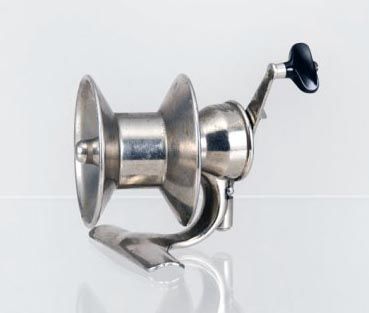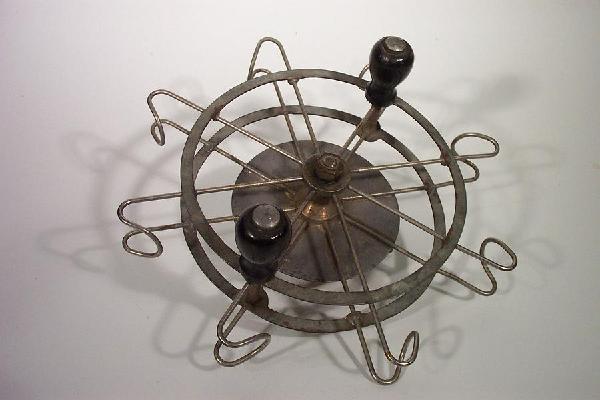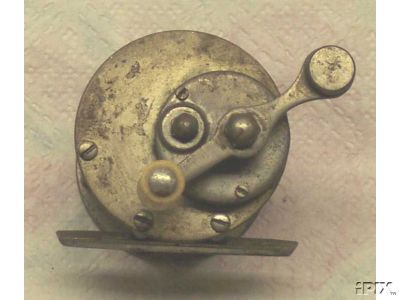If you've ever wondered how some of the odder reels were received in their day, well, Onnie Warren Smith (O.W. Smith) can help you understand that if a reel looks weird, it probably had a weird reception. In his great book Casting Tackle and Methods (1920), Smith wrote up a section he charmingly called "Freak Winches" about a number of such reels. Today, these reels have great collector value, but at the time, they were seen as the same kind of oddity as they are today.
FREAK WINCHES
I have already referred to what I may term "freak reels," a great many of which were still-born or lived a short life though there is still any number upon the market. After all, the angling fraternity is somewhat conservative; it will not stand for a too radical innovation. A change must come gradually if it is to be adopted. There may be good points about a freak reel, but because it is a freak it will stand little show of even a fair try-out. I, Philistine though I am, do not care for a reel too different. Naturally in writing of these odd reels from my collection I will refrain from commenting upon their merits and demerits to any great extent, leaving the reader to determine in his own mind their respective value.
The "Gyratory Reel" was brought to my home by a traveling representative of a certain hardware house, a "special" he was then pushing. We tried it out on the street to the great amusement of a crowd that soon gathered and they were not all fishermen either. The name—"Gyratory"—gives a very good idea of the winch, referring to the eccentric action of the spool,wobbling from left to right like a lodge goat, with each revolution, laying the line from end to end of the spool. A lever frees the spool from the crank-shaft so that it is a "freespool." It will be noticed that it is built in the handle of the rod, is a part of the rod. The crank is of peculiar shape. All in all, I consider it one of the strangest creations ever produced for winding a line or casting. However, it certainly will handle a line in a manner to surprise the doubting Thomases, but a man would need to be possessed of more than a little courage to take the arrangement out in company on a bass-lake. Yet it may become popular.


Another odd bass reel which came into my possession a few years ago, was the "Kenward Special," though there is nothing radically strange about it save the arrangement for thumbing. It is somewhat like the well-known single actions—"Experts"— which are so popular with trout-fly-fishermen, only much larger, being something like seven inches in diameter, a single revolution of the spool retrieving nearly two feet of line. The handle is simply two knobs fastened directly to the reel-head. At the base of the reel is a concave surface provided for the thumb, the idea being to facilitate thumbing. Though I tried out the reel somewhat at length I never succeeded in getting the hang of it, the side weight tipping the rod over in spite of my best efforts. I have always been sorry that I let those two reels get out of my collection and would be very glad indeed to replace them.

One sometimes sees listed, I never happened to see them in actual use, reels built in the rod handle. The innovation seems too great for the average fisherman; though one can easily discover certain advantages that such an arrangement would have, it would also have several disadvantages. The spooling of the line properly might be something of a problem, while, if not of the take-down style, a backlash would be quite difficult of solution; upon the other hand, the weight of the reel is in the center and the rod will not turn in the hand. (Parenthetically, I have often thought that without the off-set handle, same attached directly to the reel plate as in single action reels, one would have a perfect winch for trout bait fishing along brushy creeks, nothing to catch in the brush, one could even drag the rod after him without fear of entanglement.)
Some two years ago I received a sample "Thumezy" reel, a surprising bit of machinery. Made of German silver, put together in a workmanlike manner, it is a reel apparently built for a lifetime. The inventive genius who produced the "Thumezy" must have sat up nights thinking out the various things his winch will accomplish. Just to enumerate: the metal thumb-stall thumbs the spool, the thumb is not worn by contact with the line, and by pressing down to the lowest possible point, the spool is automatically freed from the winding gear, becomes free, so for casting it is a free-spool; to wind in, the operator but presses in on the handle which instantly connects the spool with the gear; slide on the click on the rear plate and advance the thumb-stall notch by notch—6 of them—the tension is increased with each, at the seventh the click, is thrown off, the spool becomes free once more; remove the two thumb-screws at either end, which takes the place of oil-caps, and the reel falls apart. I do not know that I have enumerated all the special features possessed by this winch, but surely I have mentioned enough to convince you that the "Thumezy" is "different" alright; however, it should not be called a "freak" for it is a practical reel.
The "Stockford" is not a radical innovation and in nowise a freak though it appears odd. The gear is enclosed in a small gear-box attached to the outside of the head-plate, small, inconspicuous and light. The striking original feature is the lack of pillars; the ordinary reel has three above the reel-plate, the "Stockford" has but one, and that low down in the rear. The spool being open, in case of even a superlatively bad back-lash, it would not be necessary to take the reel apart, the operator can get at the line with ease. Do not imagine that because of few pillars the frame is weak and wobbly; it is unusually firm and rigid. By the way, the open frame and gear box is used to some extent by other makers; the former is a great convenience, while the latter reduces the weight of the reel.

To continue discussing the various patterns which from time to time have-come from original makers, would be a pleasure, but we have mentioned a sufficient number to prove that there is a reel for the lover of the unusual, and wide awake inventors are racking if not wrecking their brains to produce something different. Any day, perhaps, some angling, tool-wise Walton will invent a casting reel that will revolutionize the sport, who knows? However, I am free to admit that I am a conservative of the conservatives. I do not ask my reel to do all the work. I desire to do the major part of it myself. I prefer the simple un-everything reel. Just the same, there is no greater treat in store for the lover of bass tackle than to stand before a well filled reel cabinet, displaying the various orthodox and heterodox winches that have been produced; undoubtedly many of them spell tragedy for some inventor.
-- Dr. Todd
No comments:
Post a Comment